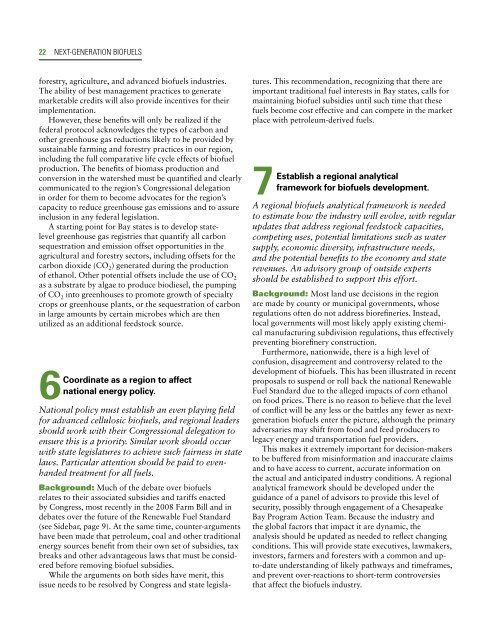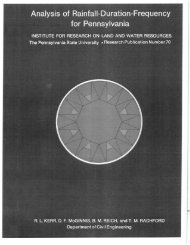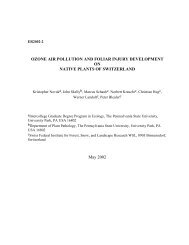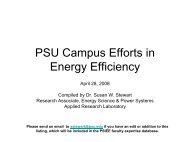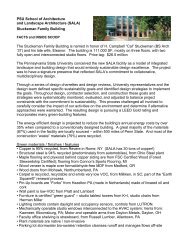Next-Generation Biofuels - Penn State Institutes of Energy and the ...
Next-Generation Biofuels - Penn State Institutes of Energy and the ...
Next-Generation Biofuels - Penn State Institutes of Energy and the ...
Create successful ePaper yourself
Turn your PDF publications into a flip-book with our unique Google optimized e-Paper software.
22 NEXT-GENERATION BIOFUELS<br />
forestry, agriculture, <strong>and</strong> advanced bi<strong>of</strong>uels industries.<br />
The ability <strong>of</strong> best management practices to generate<br />
marketable credits will also provide incentives for <strong>the</strong>ir<br />
implementation.<br />
However, <strong>the</strong>se benefits will only be realized if <strong>the</strong><br />
federal protocol acknowledges <strong>the</strong> types <strong>of</strong> carbon <strong>and</strong><br />
o<strong>the</strong>r greenhouse gas reductions likely to be provided by<br />
sustainable farming <strong>and</strong> forestry practices in our region,<br />
including <strong>the</strong> full comparative life cycle effects <strong>of</strong> bi<strong>of</strong>uel<br />
production. The benefits <strong>of</strong> biomass production <strong>and</strong><br />
conversion in <strong>the</strong> watershed must be quantified <strong>and</strong> clearly<br />
communicated to <strong>the</strong> region’s Congressional delegation<br />
in order for <strong>the</strong>m to become advocates for <strong>the</strong> region’s<br />
capacity to reduce greenhouse gas emissions <strong>and</strong> to assure<br />
inclusion in any federal legislation.<br />
A starting point for Bay states is to develop statelevel<br />
greenhouse gas registries that quantify all carbon<br />
sequestration <strong>and</strong> emission <strong>of</strong>fset opportunities in <strong>the</strong><br />
agricultural <strong>and</strong> forestry sectors, including <strong>of</strong>fsets for <strong>the</strong><br />
carbon dioxide (CO 2 ) generated during <strong>the</strong> production<br />
<strong>of</strong> ethanol. O<strong>the</strong>r potential <strong>of</strong>fsets include <strong>the</strong> use <strong>of</strong> CO 2<br />
as a substrate by algae to produce biodiesel, <strong>the</strong> pumping<br />
<strong>of</strong> CO 2 into greenhouses to promote growth <strong>of</strong> specialty<br />
crops or greenhouse plants, or <strong>the</strong> sequestration <strong>of</strong> carbon<br />
in large amounts by certain microbes which are <strong>the</strong>n<br />
utilized as an additional feedstock source.<br />
6Coordinate as a region to affect<br />
national energy policy.<br />
National policy must establish an even playing field<br />
for advanced cellulosic bi<strong>of</strong>uels, <strong>and</strong> regional leaders<br />
should work with <strong>the</strong>ir Congressional delegation to<br />
ensure this is a priority. Similar work should occur<br />
with state legislatures to achieve such fairness in state<br />
laws. Particular attention should be paid to evenh<strong>and</strong>ed<br />
treatment for all fuels.<br />
Background: Much <strong>of</strong> <strong>the</strong> debate over bi<strong>of</strong>uels<br />
relates to <strong>the</strong>ir associated subsidies <strong>and</strong> tariffs enacted<br />
by Congress, most recently in <strong>the</strong> 2008 Farm Bill <strong>and</strong> in<br />
debates over <strong>the</strong> future <strong>of</strong> <strong>the</strong> Renewable Fuel St<strong>and</strong>ard<br />
(see Sidebar, page 9). At <strong>the</strong> same time, counter-arguments<br />
have been made that petroleum, coal <strong>and</strong> o<strong>the</strong>r traditional<br />
energy sources benefit from <strong>the</strong>ir own set <strong>of</strong> subsidies, tax<br />
breaks <strong>and</strong> o<strong>the</strong>r advantageous laws that must be considered<br />
before removing bi<strong>of</strong>uel subsidies.<br />
While <strong>the</strong> arguments on both sides have merit, this<br />
issue needs to be resolved by Congress <strong>and</strong> state legislatures.<br />
This recommendation, recognizing that <strong>the</strong>re are<br />
important traditional fuel interests in Bay states, calls for<br />
maintaining bi<strong>of</strong>uel subsidies until such time that <strong>the</strong>se<br />
fuels become cost effective <strong>and</strong> can compete in <strong>the</strong> market<br />
place with petroleum-derived fuels.<br />
7<br />
Establish a regional analytical<br />
framework for bi<strong>of</strong>uels development.<br />
A regional bi<strong>of</strong>uels analytical framework is needed<br />
to estimate how <strong>the</strong> industry will evolve, with regular<br />
updates that address regional feedstock capacities,<br />
competing uses, potential limitations such as water<br />
supply, economic diversity, infrastructure needs,<br />
<strong>and</strong> <strong>the</strong> potential benefits to <strong>the</strong> economy <strong>and</strong> state<br />
revenues. An advisory group <strong>of</strong> outside experts<br />
should be established to support this effort.<br />
Background: Most l<strong>and</strong> use decisions in <strong>the</strong> region<br />
are made by county or municipal governments, whose<br />
regulations <strong>of</strong>ten do not address biorefineries. Instead,<br />
local governments will most likely apply existing chemical<br />
manufacturing subdivision regulations, thus effectively<br />
preventing biorefinery construction.<br />
Fur<strong>the</strong>rmore, nationwide, <strong>the</strong>re is a high level <strong>of</strong><br />
confusion, disagreement <strong>and</strong> controversy related to <strong>the</strong><br />
development <strong>of</strong> bi<strong>of</strong>uels. This has been illustrated in recent<br />
proposals to suspend or roll back <strong>the</strong> national Renewable<br />
Fuel St<strong>and</strong>ard due to <strong>the</strong> alleged impacts <strong>of</strong> corn ethanol<br />
on food prices. There is no reason to believe that <strong>the</strong> level<br />
<strong>of</strong> conflict will be any less or <strong>the</strong> battles any fewer as nextgeneration<br />
bi<strong>of</strong>uels enter <strong>the</strong> picture, although <strong>the</strong> primary<br />
adversaries may shift from food <strong>and</strong> feed producers to<br />
legacy energy <strong>and</strong> transportation fuel providers.<br />
This makes it extremely important for decision-makers<br />
to be buffered from misinformation <strong>and</strong> inaccurate claims<br />
<strong>and</strong> to have access to current, accurate information on<br />
<strong>the</strong> actual <strong>and</strong> anticipated industry conditions. A regional<br />
analytical framework should be developed under <strong>the</strong><br />
guidance <strong>of</strong> a panel <strong>of</strong> advisors to provide this level <strong>of</strong><br />
security, possibly through engagement <strong>of</strong> a Chesapeake<br />
Bay Program Action Team. Because <strong>the</strong> industry <strong>and</strong><br />
<strong>the</strong> global factors that impact it are dynamic, <strong>the</strong><br />
analysis should be updated as needed to reflect changing<br />
conditions. This will provide state executives, lawmakers,<br />
investors, farmers <strong>and</strong> foresters with a common <strong>and</strong> upto-date<br />
underst<strong>and</strong>ing <strong>of</strong> likely pathways <strong>and</strong> timeframes,<br />
<strong>and</strong> prevent over-reactions to short-term controversies<br />
that affect <strong>the</strong> bi<strong>of</strong>uels industry.


